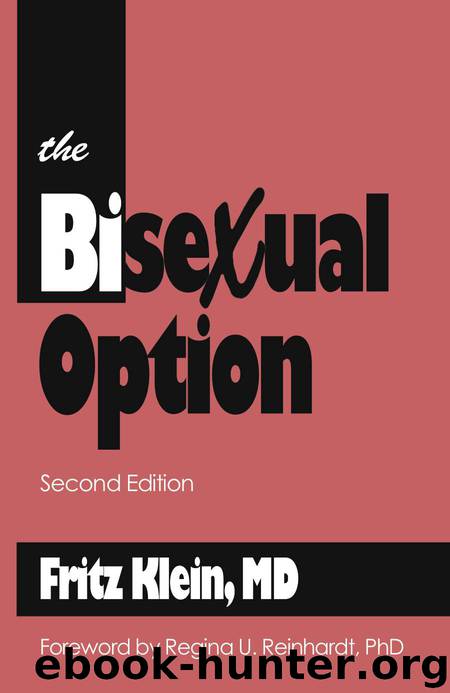The Bisexual Option by Fritz Klein MD

Author:Fritz Klein MD [Klein MD, Fritz]
Language: eng
Format: mobi
Publisher: American Institute of Bisexuality, Inc.
Published: 1993-06-30T16:00:00+00:00
PART III: THE BISEXUAL IN SOCIETY
CHAPTER 8
Sociological Findings
Sociology is the study of human beings in groups, in communities of all kinds–mainstream or marginal, privileged or oppressed, “above-ground” or “underground.” On the level of sexuality, homosexuals and heterosexuals constitute such communities. They overlap in professional and family life, but sexually at least, the lines of demarcation are clear. But why should this be so?
“Good fences make good neighbors,” Robert Frost’s farmer advises. But Frost questions that. Why do good fences make good neighbors? He gets no answer from the farmer, who is not speaking out of wisdom but out of fear.
Male and female homosexuals have formed their own communities because no room was made for them in the mainstream. They couldn’t join fully in the mainstream without loss of personal identity as men, as women–as human beings. They renamed themselves “gay” and “lesbian,” which they preferred to the straight world’s labels of “queer” and “dyke” (though some of course have since defiantly readopted those terms).
A male operating freely in both homosexual and the heterosexual world can choose to define himself as bisexual and not need to form or join his own subculture. He doesn’t need the fence. He can live in both communities, moving back and forth as his needs or desires dictate. Although he may decide to hide his “queerness” from the straights and his “closet behavior” from the gays, he does not necessarily need to belong to a community of bisexuals. He is among his kind when he is among human beings.
This is not to say that a need for a bisexual community doesn’t exist at all. It does. But not for the same reasons the male and female homosexuals created their subculture. Men and women gather together into groups primarily for mutual protection and support. The bisexual can survive in either the heterosexual or homosexual camp, or both, and that makes him or her an elusive subject for the sociologist. If there were such a thing as a bisexual community, there would doubtless not be as few sociological studies as there are.
Philip W. Blumstein and Pepper Schwartz, of the Department of Sociology at the University of Washington, have done extensive sociological work on bisexuality, published in Sexual Deviance and Sexual Deviants. They report:
We know that a great many people have sexual relations with members of both sexes. Seldom do they claim to divide their attention and commitment absolutely equally (hence the misleading quality of the term bisexual), but both types of sexual experience have independent importance for them. Despite the documented existence of large numbers of such people, one is hard-pressed to find much systematic scientific literature on the topic of bisexuality. Psychoanalysis, for example, has already declared itself on this issue: it is irrelevant. Orthodox Freudian analysts feel that bisexuality does not exist as a clinical entity; a person is either heterosexual or homosexual. The person’s expressed self-identification is of no consequence, except as a symptom of inability to come to grips with his or her true sexuality.
Download
This site does not store any files on its server. We only index and link to content provided by other sites. Please contact the content providers to delete copyright contents if any and email us, we'll remove relevant links or contents immediately.
Rewire Your Anxious Brain by Catherine M. Pittman(18292)
Talking to Strangers by Malcolm Gladwell(12869)
The Art of Thinking Clearly by Rolf Dobelli(9909)
Mindhunter: Inside the FBI's Elite Serial Crime Unit by John E. Douglas & Mark Olshaker(8699)
Becoming Supernatural by Dr. Joe Dispenza(7833)
Change Your Questions, Change Your Life by Marilee Adams(7371)
The Road Less Traveled by M. Scott Peck(7278)
Nudge - Improving Decisions about Health, Wealth, and Happiness by Thaler Sunstein(7242)
The Lost Art of Listening by Michael P. Nichols(7159)
Mastermind: How to Think Like Sherlock Holmes by Maria Konnikova(6936)
Enlightenment Now: The Case for Reason, Science, Humanism, and Progress by Steven Pinker(6871)
Win Bigly by Scott Adams(6826)
The Way of Zen by Alan W. Watts(6288)
Daring Greatly by Brene Brown(6222)
Big Magic: Creative Living Beyond Fear by Elizabeth Gilbert(5351)
Grit by Angela Duckworth(5295)
Men In Love by Nancy Friday(4963)
Ego Is the Enemy by Ryan Holiday(4956)
Altered Sensations by David Pantalony(4864)
